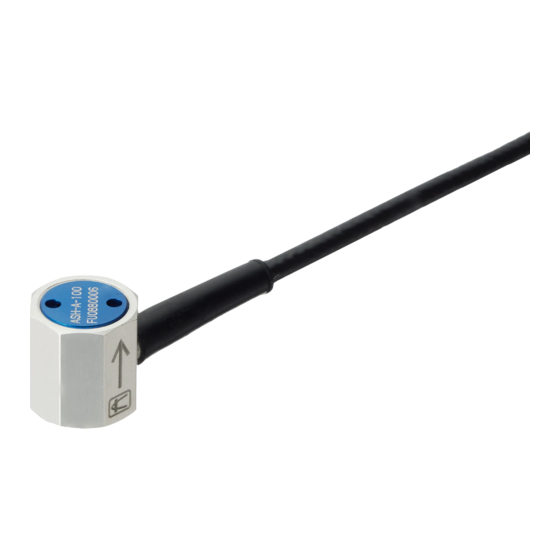
Advertisement
ASH-A Acceleration Transducers INSTRUCTION MANUAL
Thank you for purchasing this KYOWA product. Before using it, please read this
instruction manual carefully. Also, keep the manual within easy reach so that you
can refer to whenever necessary.
Specifications and dimensions described in this manual could be changed without
notice. Please visit our website for the latest version.
1. Calling the operator's attention
Be sure to observe the accompanying precautions in order to safeguard the
operator and preserve the performance of the instrument.
Improper operation of the system may result in severe
Warning
injury of the operator.
Caution
It is a precaution to operate properly.
2. Safety precautions
Be sure to mount the product properly.
If the product loosens while using it, the product may be detached or
damaged, and operators may be damaged.
3. Mounting
3.1 The dimensions of each transducer are illustrated below.
To mount the transducer, carefully align its sensing direction with the direction
of acceleration and use adhesive.
Outline drawing of the ASH-A-10 to 50
Indicates the center of mass of the acceleration transducer.
Outline drawing of the ASH-A-100 to 1K
.
Indicates the center of mass of the acceleration transducer.
Warning
3.2 Thoroughly clean the bonding area of the measuring object. Remove dust, oil
and rust from the area using sandpaper and acetone.
Also, thoroughly clean the mounting surface of the transducer.
3.3 Fix with adhesive (cyanoacrylate instantaneous adhesive etc.).
3.4 Be sure to fix the cable to the measurement object as much close as
possible to the transducer mainframe. If circumstances do not allow to fix the
cable to the measurement object, let the cable to slack in such a manner that
it will not be pulled after mounting.
3.5 The transducer cannot be mounted to a curved surface. Use a jig or prepare
a flat mounting area on the curved surface.
3.6 The polarity of transducer output against acceleration
The relation between the direction of acceleration applied to the transducer
and the polarity of transducer output are illustrated below.
Caution
Do not disassemble the transducer.
The transducer is very sensitive to shocks. If the transducer is dropped or hit
by a hard matter, thus receiving impact in excess of the allowable overload
rating, damage may be caused. To avoid harm, be sure to handle it very
carefully.
After the transducer fixation, avoid plucking the cable, swinging around
having a cable, if not, the transducer may be disconnection. Take great care
to handle it properly.
Install the transducer carefully because its frequency characteristics may vary
depending on the state of installation. The ideal installation is such that the
transducer completely and firmly adheres to a measuring object. Avoid such
manners as to subject the transducer to a bending or twisting force.
The transducer is not waterproof, therefore avoid using it where it may be
exposed to water or in environments whose humidity is over 85 %.
4. Connection
4.1 Connect the transducer to a strain amplifier.
4.2 Observe the pin assignment of the connector illustrated below.
Caution
A bridge excitation voltage should be in a range of 2 V. A bridge excitation
voltage other than 2 V does not satisfy the specifications.
Be sure to start measurement 5 minutes or a longer time after power was
switched on.
IM-T-303
Mar. 2020
Advertisement
Table of Contents

Subscribe to Our Youtube Channel
Summary of Contents for KYOWA ASH-A-10
- Page 1 Mar. 2020 ASH-A Acceleration Transducers INSTRUCTION MANUAL Thank you for purchasing this KYOWA product. Before using it, please read this 3.2 Thoroughly clean the bonding area of the measuring object. Remove dust, oil instruction manual carefully. Also, keep the manual within easy reach so that you and rust from the area using sandpaper and acetone.
- Page 2 :See table above. If the measured values differ from the calibration sheet, the cause may be Transverse Sensitivity :2%RO or less failure of the sensing element. In this case, contact KYOWA or our Weight :Approx. 13g (ASH-A-10 to 50) representatives.
- Page 3 注意 正しく動作させるための注意です。 2. 安全上のご注意 警告 本製品の取り付けが不十分な場合,衝撃により外れた本製 品が当たって怪我をする恐れがあります。取り付け方法を 守ってご使用ください。 3. 取り付け 注意 3.1 外観寸法は下図のようになっています。 感度方向を正しく合わせ,接着剤により取り付けます。 本製品を分解しないでください。 本製品は衝撃に対して敏感に出来ています。落としたり, ASH-A-10~50 外観図 硬いものにぶつけるなど,許容過負荷を超える衝撃を本体 に与えた場合、破損する恐れがあります。 変換器本体を固定後にケーブルを引っ張ったり,ケーブル を持って振り回すと断線する恐れがあります。 本製品の取り付けは,その状態により周波数特性が変化す る場合があります。被測定物と完全密着した取り付けが理 想的であり,変換器本体に曲げやねじりなどの外力が加わ るような取り付けは良くありません。 本製品は防水処理を施していないので,水のかかる場所や 湿度 85%以上の環境下では使用できません。 4. 接続・測定 4.1 本製品をひずみ測定器に接続します。...
- Page 4 a:片振幅 (m) (シールドは本体に接続されていません) f:振動数 (Hz) ◆機械的特性 7. 保管上の注意および点検 許容過負荷 :300% 応答周波数 :上記表参照 7.1 コネクタには水,油,塵などがつかないようにしてくだ 横感度 :2%RO 以下 さい。 質量 :ASH-A-10~50 約 13g(ケーブル含まず) 7.2 使用後は汚れを取り,収納ケースに保管してください。 ASH-A-100~1K 約 6.5g (ケーブル含まず) 7.3 初期値,指示値が異常と思われる場合は,入力抵抗,出 力抵抗,本体とケーブル心線間の絶縁抵抗(100MΩ以上) ◆付属品 を測定してください。 取扱説明書 :1部(本書) 測定値が異常の場合,本器の故障と考えられます。弊社 検査成績書 :1部 営業までご連絡ください。 注意...












Need help?
Do you have a question about the ASH-A-10 and is the answer not in the manual?
Questions and answers